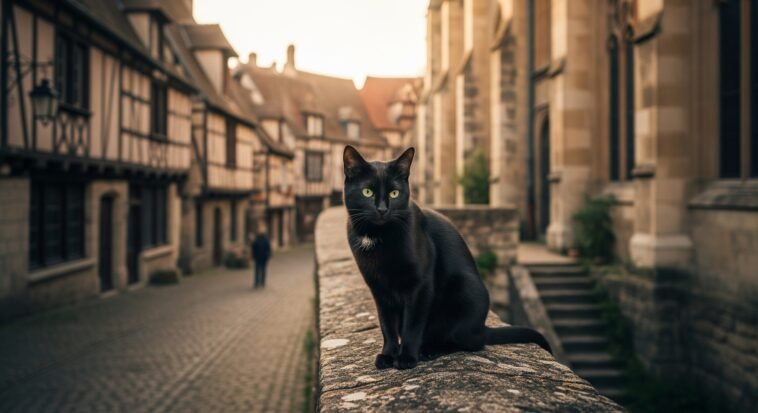
In 1730s Paris, two print shop apprentices staged what historian Robert Darnton called “the funniest thing that ever happened” at work—by torturing and killing cats.
It sounds brutal (because it is), but it wasn’t just senseless cruelty.
In his book The Great Cat Massacre, Darnton explains that this bizarre act was actually a twisted form of protest.
The apprentices used the cat killings to mock their bosses and push back against class inequality.
It was their way of flipping the power dynamic—ugly, yes, but deeply symbolic of how working-class frustration boiled over in pre-revolutionary France.
Historical Context: Life in 18th Century France
In 1700s France, printing shops ran on strict hierarchy.
At the top were the master printers—wealthy, respected, and living comfortably. At the bottom? Apprentices.
Mostly teenage boys, stuck in freezing attics, working long hours for scraps.
It looked more like servitude than training.
And while the apprentices barely got by, the master’s cats lived like royalty—well-fed, pampered, and free to roam.
That contrast wasn’t lost on the boys stuck sweeping floors.
Cats, back then, weren’t the cute house pets we meme about today. In the countryside, people linked them to witchcraft and fertility.
In cities, they were pest control with attitude.
But in homes like the printmaster’s, they symbolized status—fat, spoiled animals that ate better than the workers.
That’s part of why the “cat massacre” hit so hard: it was about way more than just animals.
- Read also: Liberty vs Equality: The French Revolution vs American Revolution
- Read also: The Rise and Fall of the Jacobins in the French Revolution

The Massacre: What Actually Happened
The account of Nicolas Contat
Most of what we know about this bizarre event comes from Nicolas Contat, a young apprentice in 18th-century Paris who later wrote about it.
He and another apprentice, Léveillé, worked for a harsh printing master.
Their lives were rough—cold room, barely any food, up before sunrise, and constant beatings.
What pushed them over the edge wasn’t just the abuse—it was the cats.
Their master’s wife adored her cats. Fed them well. Kept them warm. Treated them like royalty.
Meanwhile, the apprentices were starving and freezing.
Imagine being treated worse than a house pet. That’s what broke them.
The plan unfolds
One of them started meowing at night.
Loud, creepy cat noises outside the master’s bedroom window. Every night.
The idea was to make him think the neighborhood cats had gone wild. It worked. He couldn’t sleep. He snapped.
The master finally told the apprentices to get rid of all the cats. That’s when things got dark.
They didn’t just kill the cats. They made it a show.
They rounded them up, knocked them out, and staged a fake courtroom trial before the executions.
It was gruesome—but to the apprentices, it was hilarious. They laughed about it for years.
The aftermath and meaning
This wasn’t just about cats. It was payback.
They tricked their master into ordering the deaths of animals he loved.
It was their way of flipping the power dynamic—using his authority to get revenge.
In their eyes, they finally got the upper hand.
It’s like something out of Fight Club, but instead of blowing up buildings, they killed cats to expose the rot in their little corner of society.
It was petty. Cruel. But to them, it was justice.
Cultural and Social Analysis
Symbolic Rebellion and Power Dynamics
Historian Robert Darnton saw this cat massacre as more than just animal cruelty—it was a twisted form of protest.
The apprentices didn’t have the power to fight their master outright.
So they got clever. They used the one thing he loved—his cats—and made him destroy them himself.
That flipped the script. He still had authority on paper, but they were pulling the strings.
They didn’t pick cats randomly, either.
In that house, cats had what the apprentices didn’t: warmth, food, affection.
So when they killed the cats, it wasn’t just out of spite—it was about taking down what the cats represented.
They turned the whole thing into a fake trial, almost like a parody of justice, mocking the very order that kept them at the bottom.
Gender and sexual undertones
And then there’s the gender piece.
In 18th-century France, cats weren’t just pets—they symbolized femininity, sexuality, even fertility.
The master’s wife doted on them. That mattered.
So when the apprentices went after the cats, it wasn’t just an attack on animals—it was an indirect hit on her.
And by dragging her husband into it, they were also taking a swing at his control over the home.
Basically, they humiliated him by making him betray his own household, turning him into the guy who couldn’t protect his wife’s favorite things.

Broader Historical Significance
A Window into Pre-Revolutionary France
The Great Cat Massacre isn’t just a weird, dark story—it actually says a lot about France before the Revolution.
It shows how deep the frustration ran among working-class people.
These apprentices didn’t have rights or status, but they still found a way to hit back. And they did it without breaking the rules outright.
That’s what makes it so interesting—they used the system to mess with the people in charge.
The way they pulled this off—using tricks, not force—shows they understood power really well.
They flipped their master’s authority on itself, made him destroy the very things he cared about.
That kind of reversal? It’s the same kind of energy that would fuel the Revolution years later.
Not just chaos, but smart, symbolic rebellion.
Attitudes Toward Violence and Animals
As brutal as it sounds now, the violence in this story didn’t stand out much back then.
People went to public executions like it was a festival. Animal cruelty was part of street life and even celebrations.
So the apprentices weren’t doing something wildly out of step with their time.
But here’s what makes it stand out: they didn’t just kill the cats. They staged a whole fake trial.
They turned it into theater. That tells us something—maybe even they felt like raw violence wasn’t enough.
They needed a reason, even if it was fake.
That performance made the violence feel bigger than just anger. It gave it meaning.
Historical Debates and Interpretations
Scholarly perspectives
Not everyone buys the story exactly how Robert Darnton tells it.
Some historians think Contat—the apprentice who wrote it all down—might’ve exaggerated or made parts up.
They say it could’ve been more of a cruel joke than some deep social commentary. Fair point.
Others argue Darnton went too far with the symbolism.
Maybe it wasn’t a layered act of rebellion. Maybe it was just bored apprentices being awful.
Still, even if the story isn’t 100% factual, it hits a nerve. It feels true to the vibe of pre-revolution France.
The fact that it kept getting passed around means people related to it.
It captured something real about life under a strict social hierarchy—what it felt like to be stuck at the bottom, angry, and powerless.
Modern relevance
What keeps people talking about the Great Cat Massacre isn’t just how bizarre it was.
It’s what it shows us about power and how people fight back.
The apprentices didn’t start a riot—they played the long game.
They used humor, manipulation, and symbols to get their revenge. That kind of quiet resistance shows up everywhere in history.
And yeah, it’s uncomfortable. They laughed while killing animals.
That’s hard to stomach now. But it also makes us think about the line between humor and cruelty.
How jokes can carry real pain. How violence can be disguised as performance or protest.

- Read also: From Royals to Radicals: 10 Key Figures of The French Revolution
- Read also: A Timeline of the French Revolution: Key Events from 1787 to 1799
Conclusion: What the Cat Massacre Actually Tells Us
The Great Cat Massacre is hard to forget—and for good reason.
It’s brutal, but it tells us a lot about life in 18th-century France.
The violence is disturbing, but the apprentices weren’t just being cruel for fun. They were stuck at the bottom of the social ladder, and this was their twisted way of pushing back.
Robert Darnton’s take reminds us that history isn’t just kings and revolutions—it’s also the messed-up stuff ordinary people did to survive, cope, or resist.
The apprentices didn’t have real power, so they used symbols and dark humor to make a point. And it landed.
This story matters because it shows how anger at inequality doesn’t always show up in speeches or riots.
Sometimes, it’s in weird, awful stories that people laughed at back then—even if they horrify us now.



